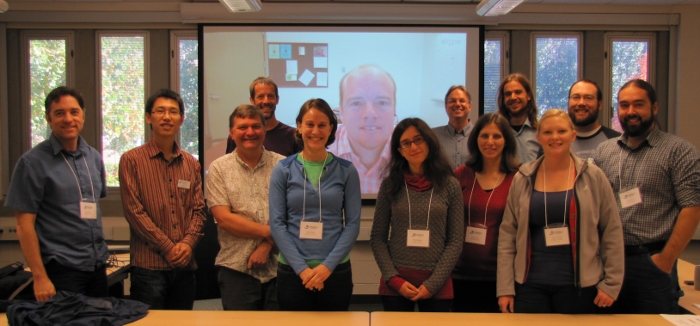| Description | Participants | Summaries | Products |
|---|

Archived NIMBioS Working Group
Plant-Soil Feedback Theory
Topic: Theory of plant-soil feedback: Phenomenological, mechanistic and spatial models
Meeting dates: Oct 31 - Nov 2, 2013; Apr 28-30, 2014; Nov 3-5, 2014; May 26-29, 2015
Organizers:
James Bever, Biology, Indiana Univ., Bloomington
Maarten Eppinga, Environmental Science, Copernicus Institute, Utrecht Univ., The Netherlands
Objectives: The framework of plant-soil community feedback has been successful at integrating the effects of soil microbes into plant-plant interactions. This framework has provided theoretical and empirical support for a central role of soil micro-organisms in stabilizing the co-existence of competing plant species, determining the abundance of plant species within communities, creating spatial heterogeneity in community composition and driving vegetation change over time. A major strength of this framework is that its theoretical predictions are closely connected with the setup of experiments, enabling a direct assessment of how plant-soil interactions scale up to a net feedback effect at the plant community level. However, confrontation of theoretical predictions with empirical data has also uncovered a conceptual shortcoming of current theory. Observations from real ecosystems show that positive and negative plant-soil feedbacks may act concurrently, but current theory has yet to incorporate simultaneous negative and positive feedbacks and their consequences for plant community structure within a spatio-temporal mosaic. To this end, we have assembled a working group composed of empiricists studying plant-soil feedbacks and their role in plant community structure and theoreticians studying plant-soil feedbacks using a variety of mathematical modeling approaches. Our goals are 1) to extend current spatial and mean-field models of plant-soil feedback to more fully incorporate both positive and negative feedbacks between soil micro-organisms and individual plant species and the consequences of these interactions for plant community structure and change over time; and 2) to parameterize and test these models with existing data sets on plant-soil feedback and community structure.

Meeting Summaries
| Mtg # | Dates | Agenda | Summary | Photo | Evaluation |
|---|---|---|---|---|---|
| 1 | Oct 31-Nov 2, 2013 | Link | Link | Report | |
| 2 | Apr 28-30, 2014 | Link | |||
| 3 | Nov 3-5, 2014 | Link | Link | ||
| 4 | May 26-29, 2015 | Link | Link |
Meeting 1 Summary. Ecosystems host a perplexing diversity of plant species. Understanding the mechanisms responsible for creating and maintaining this diversity has receiving considerable attention, but the fundamental mechanisms driving plant diversity patterns are not fully understood. Increasing our understanding is pivotal for the development of management strategies to combat observed declines in biodiversity within a changing climate. Empirical observations suggest an important role of soil organisms in maintaining aboveground diversity. However, many observations are not closely linked to theory, hampering generalization of case studies towards understanding maintenance of diversity across the globe. This working group brings together empiricists and theoreticians interested in understanding the potential role of soil community organisms driving diversity patterns within plant communities. In this first meeting, an overview was provided by the theoretical, observational and experimental approaches employed by the participants, as well as a discussion about ways in which these approaches can be combined in the future to address outstanding questions in the field. In the first meeting, the Working Group outlined the outstanding questions in the field that it will work on in sub-groups in future meetings. The four most prominent questions posed were: 1) What are the essential metrics capturing plant-soil feedback? 2) How does the framework of plant-soil feedback compare to more classical theories of plant competition and diversity? 3) What model approaches can capture simultaneous occurrence of positive and negative plant-soil feedbacks? 4) What is the role of plant soil feedback in creating and maintaining spatial structure in plant communities? The details for each sub-project were elaborated upon in a series of breakout sub-group meetings. The participants will continue to work on the sub-projects in the coming months, and synthesize findings during the second working group in April 2014.
Meeting 2 Summary. In the second meeting, the participants mostly worked in breakout sub-group meetings, with each subgroup focusing on one of the previously outlined questions. The practical work mainly focused on addressing questions 1, 3 and 4. How to proceed with investigating question 2 was mainly discussed in plenary group meetings based on progress made since the last working group meeting. For each question, the practical work is being done by sub-project team that was assembled during the first Working Group meeting. The participants will continue with the practical work within the sub-projects in the coming months, and the sub-project members will discuss progress regularly during Skype meetings. Also, regular Skype meetings for the entire working group have been planned for the period between this meeting and the third working group meeting, to be held around October 2014.
Meeting 3 Summary. In the third meeting, questions were addressed in break-out groups. Some of the Working Group members switched among the breakout groups in order to ensure an optimal balance between theoreticians and empiricists for the specific tasks at hand. With regard to question 1, the group has integrated the data collected by individual members since the second meeting, and analysis of the full data set was started during the meeting. The group focusing on question 2 has been able to formulate an analysis framework for the formulated plant-soil feedback population models, and the first analyses using this framework have been performed. The group focusing on question 3 has been able to formulate null model predictions for the spatial models in a systematic way, and the data needed to test future model predictions have been extracted from a large dataset of tree species diversity and recruitment in North American temperate forests. Each sub-group is now ready to draft a manuscript, which will be developed and discussed during Skype meetings before the next meeting, planned for May 2015, when the group aims to submit the manuscripts developed and organize the next research efforts made by the group.
Meeting 4 Summary. In the fourth meeting, the Working Group compiled the work done by members of the different sub-groups and started writing the results in a series of manuscripts. In addition to writing, a couple of specific activities per subgroup were also undertaken. In order to answer the first research question, a large number of statistical models were run on a large dataset of plant-soil feedbacks collected by the sub-group members. To answer the second research question, a large number of plants-mutualists-pathogens systems were analyzed over multiple ranges in parameter space to provide a coherent view on how these interactions might drive the plant community processes of succession and invasion. For the third research question, a set of models of increasing detail were developed from a simple mean field model of plant-soil feedback to an individual-based model. The sub-group members started to run in parallel a coherent set of scenarios to elucidate the role of plant-soil feedbacks in maintaining plant community structure and how these predictions depend on specific model formulations. In addition to the sub-group activities, all group members also outlined two additional synthesis papers, one of which was largely completed during the fourth meeting.
 |
| Meeting 1 participants (Back row, L to R): James Umbanhower, Scott Mangan (via Skype), James Bever, Maarten Eppinga, Keenan Mack, Jonathan Bauer. (Front, L to R): Dan Johnson, Jiang Jiang, Allan Strand, Karen Abbott, Mara Baudena, Liza Comita, Kerri Crawford. (Not Pictured): Katharine Suding. |
 |
| Meeting 3 participants: Katharine Suding, Dan Johnson, Jonathan Bauer, Scott Mangan, Maarten Eppinga, Mara Baudena, James Bever, Kerri Crawford, Jiang Jiang, Karen Abbott, Liza Comita. (Not Pictured: Keenan Mack). |
 |
| Meeting 4 participants (L to R): James Bever, Jonathan Bauer, Katharine Suding, Allan Strand, Dan Johnson, Kerri Crawford, James Umbanhower, Karen Abbott, Jiang Jiang, Maarten Eppinga, Liza Comita, Keenan Mack. Not Pictured: Mara Baudena. |
NIMBioS Working Groups are chosen to focus on major scientific questions at the interface between biology and mathematics. NIMBioS is particularly interested in questions that integrate diverse fields, require synthesis at multiple scales, and/or make use of or require development of new mathematical/computational approaches. NIMBioS Working Groups are relatively small (up to 10 participants), focus on a well-defined topic, and have well-defined goals and metrics of success. Working Groups will meet up to 3 times over a two-year period, with each meeting lasting up to 2.5 days.
A goal of NIMBioS is to enhance the cadre of researchers capable of interdisciplinary efforts across mathematics and biology. As part of this goal, NIMBioS is committed to promoting diversity in all its activities. Diversity is considered in all its aspects, social and scientific, including gender, ethnicity, scientific field, career stage, geography and type of home institution. Questions regarding diversity issues should be directed to diversity@nimbios.org. You can read more about our Diversity Plan on our NIMBioS Policies web page. The NIMBioS building is fully handicapped accessible.
NIMBioS
1122 Volunteer Blvd., Suite 106
University of Tennessee
Knoxville,
TN 37996-3410
PH: (865) 974-9334
FAX: (865) 974-9461
Contact NIMBioS


